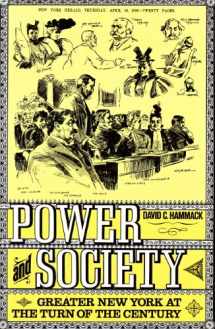
Power and Society: Greater New York at the Turn of the Century (Columbia History of Urban Life)
Book details
Summary
Description
Who has ruled New York? Has power become more concentrated--or more widely and democratically dispersed--in American cities over the past one hundred years? How did New York come to have its modern physical and institutional shape? Focusing on the period when New York City was transformed from a nineteenth-century mercantile center to a modern metropolis, David C. Hammack offers an entirely new view of the history of power and public policy in the nation's largest urban community.
Opening with a fresh and original interpretation of the metropolitan region's economic and social history between 1860 and 1910, Hammack goes on to show how various population groups and elites used their economic, social, cultural, and political resources to shape the decisions that created the modern city. By 1901 New York had the strong mayor and five borough government it has retained ever since. It had begun to provide a wide range of new services, from mass transit to secondary and higher education. And it had developed both the strong central bureaucracies and the effective Tammany Hall political organization that were to manage its affairs for the next sixty-five years.
Hammack finds that as New York grew in size and complexity its economic and social groups became increasingly diverse. Nearly half of the nation's millionaires lived in the region during the period. Men--and women--of great wealth played very active roles in public affairs. But they were deeply divided by differing economic interests and cultural loyalties, and they did not constitute a single dominant economic and social elite. Unable to agree among themselves, and forced to deal with increasingly independent Tammany Hall and Republican party organizations, they found it necessary to seek alliances with one another and with non-elite groups if they were to influence major decisions. Building on his account of this interplay between numerous elites in turn-of-the-century New York, Hammack concludes with a new interpretation of the history of power in the metropolis and in other American cities between that time and the present.
The book makes major contributions to the study of community power, of urban and regional history, and of public policy. And by taking the meaning and distribution of power as his theme, Hammack demonstrates that it is possible to overcome the fragmentation of much recent historical writing and to reintegrate economic, social, and political history into a rich and comprehensive work.


We would LOVE it if you could help us and other readers by reviewing the book
Book review



